The British Raj
Part 3: Their Own Masters As early as 1885, Indians gathered in significant numbers to discuss ways to reduce the influence of the Raj in their lives. Wars in Afghanistan and Burma were fresh in the minds of the 73 people who gathered in Bombay on Dec. 28, 1885, at the inaugural meeting of the Indian National Congress (INC). They came from nearly every province, numbering 54 Hindus, two Muslims, and 17 from other religions. Everyone spoke English, and so the The INC had as its membership middle class intellectuals who were calling for change. One of those, Surendranath Banerjea, had convened the Indian National Conference two years earlier, in Bengal. Banerjea promoted the doctrine of swadeshi, which translates loosely into English as "of our country." The idea was to buy Indian-made goods, thereby boycotting goods manufactured in the U.K., primarily, but also elsewhere. The completion of the Suez Canal in 1869 had cut the time taken for goods and people to travel from the U.K. to India from three months to three weeks. The introduction of the railroad made it easier and quicker to get foreign goods into India's heartland, where they could be sold at prices cheaper than similar Indian-made goods. The INC met on a semi-regular basis for several years. Its leaders became very well-known. Among them was Bal Tilak, a journalist behind the newspaper Kesari ("Lion"). Authorities jailed Tilak several times on charges of urging sedition through his writings, but that didn't stop him from imploring Indians to look back to what their country was before the British came and find inspiration in that introspection. 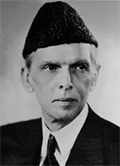
As the membership of the INC grew, its membership continued to be overwhelmingly Hindu. Sectarian violence in India was relatively rare at this time, but Muslims still felt left out of what was turning into a growing call for more autonomy. One result of this was the institution of the All-India Muslim League (AIML), in 1906. Headquarters for this organization was in Lucknow, and its first president was Syed Ahmad Khan. The philosopher-poet Muhammad Iqbal was a prominent advocate of throwing off the British yoke, as was Aga Khan III, who called long and loudly for a separate Muslim state within India. The most famous Muslim advocate of autonomy was Muhammad Ali Jinnah (right), who was also a member of the INC. The two groups made the Lucknow Pact in 1916, agreeing to work together to achieve more autonomy. Indians' fighting for the U.K. during World War I actually helped their case, and the Government of India Act 1919 made significant changes to the political landscape. Introduced in this act were a national parliament, with two houses, and the addition of 5 million Indians to the voter rolls. (These were the wealthiest and only 10 percent of the overall population, but it was a start.) In addition, Indians could now assume roles as minister of education or health or public works in a provincial government. The Act provided for a commission to meet a decade later to consider whether more reforms would be introduced. 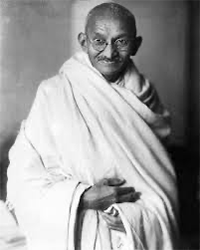
The most prominent member of the INC from the 1920s was Mohandas Gandhi. The once shy and tongue-tied lawyer had found his voice speaking out against discrimination in South Africa and had returned to his homeland at a time of great unrest. It was Gandhi who popularized the idea of satyagraha, or nonviolent resistance to violence and illegal acts. This movement gained adherents, particularly after the U.K. sent a commission to discuss constitutional reform and the result was only more conformance. On Jan. 26, 1930, Gandhi and the INC declared India independent from the U.K. The U.K. didn't agree to this change, and India was still part of the U.K.; but it was significant that this very public group had made this very public pronouncement, of its desire to leave the British Empire. One other bone of contention with the local population was that as far back as 1876, the ruling monarch had been styled Emperor of India. The first to do so was Queen Victoria, who was Empress of India. But her successors all took the title of Emperor of India. Indians still had stories about how previous generations had struggled under the rule of the Mughal emperors. Even though the U.K. emperors and empress were more benevolent by comparison, the idea of having an imperial head of state was still objectionable to many Indians. 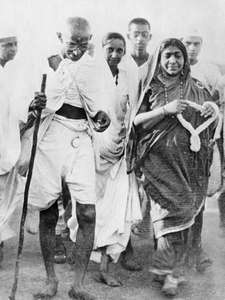
Also in 1930 occurred the Salt March, perhaps Gandhi's most famous set of events. He and several other dozen people walked 240 miles to the Arabian Sea and then, joined by thousands more people, picked up salt by the handful from the shore. They were breaking the law that said that they had to buy salt from U.K. vendors. The result was thousands of arrests. Another protest at a saltworks a month later also resulted in arrests but also resulted in police beatings of protesters. These beatings made their way into the international news, and the U.K. soldiers didn't look so civilized after all. Gandhi was held for some time but was released in January 1931. Later that year, he was summoned to the U.K. He met with Viceroy Lord Irwin, and an agreement between the two, known as the Gandhi-Irwin Pact, came about on March 5. Among the promises made by the U.K.:
Gandhi went to London a year later to participate in two Round Table conferences, to try to resolve the issues once and for all. He found the U.K. representatives to be retrenching a bit and so started another satyagraha campaign. A few years later, still wanting to keep the peace as much possible, the U.K. introduced the Government of India Act 1935, which featured:
The advent of World War II was just another opportunity for Gandhi to continue to press his case. The "Quit India" movement was born during the war, and the government in London responded by ordering him arrested and jailed for two years. Also during the war, All-India Muslim League leader Muhammad Ali Jinnah kept pressing his case as well, for a Muslim homeland. 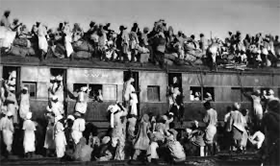
That was the ultimate result of the Partition, as the division of the Raj was known. On Aug. 15, 1947, the U.K. relinquished all claims to India, which became two countries and then three. Jinnah was the first leader of the new state of Pakistan. The first prime minister of the Union of India was Jawaharlal Nehru. Sir Cyril Radcliffe was head of the Boundaries Commission created by the Indian Independence Act 1947. Under his direction came the creation of West Pakistan and East Pakistan as Muslim-run countries and India as a Hindu-run country. The result was a huge amount of upheaval. Millions of people were forced to leave their ancestral homes, and violence was the norm for a time. Estimates are that deaths associated with these forced movements exceeded 1 million. The majority of the population did not have to move. First page > From Trade to Governance > Page 1, 2, 3
|
|
Social Studies for Kids
copyright 2002–2025
David White



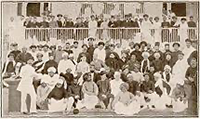 meeting was conducted in English.
meeting was conducted in English.
